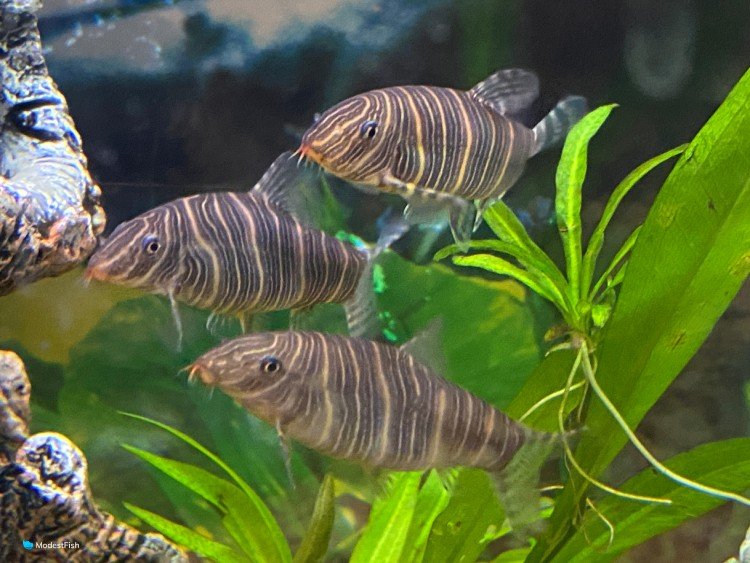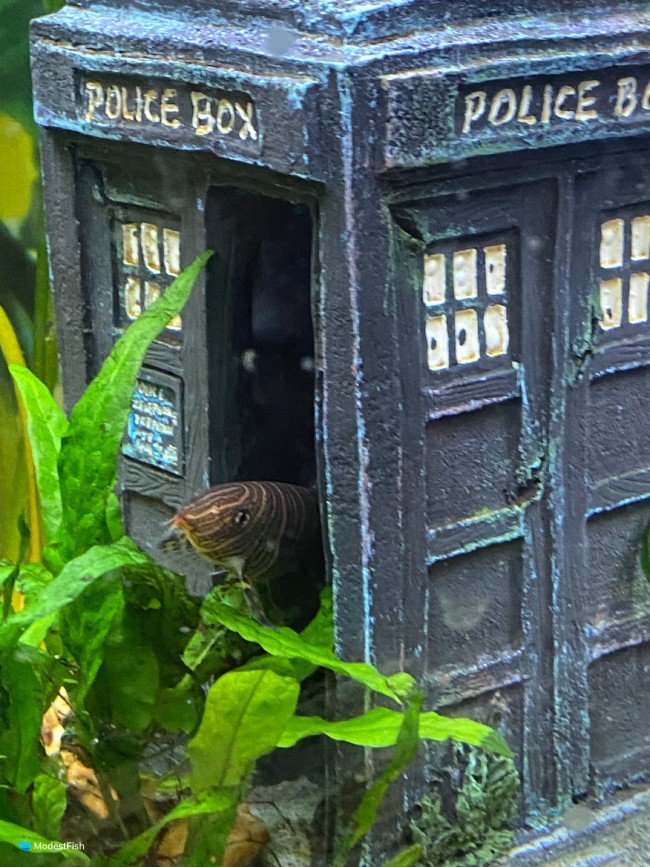Zebra loaches are a great fit for most community tanks. They generally just stick to themselves and do their own thing.
I love my school of zebra loaches, and in this guide, I’ll teach you how to set up a tank and provide the right care for zebra loaches.
Quick Stats
- Care Level: medium
- Min. Tank Size: 30 gallon (113 liter)
- pH: 6.5-7.5
- Temperature: 73°-79°F (23°-26°C)
- Diet: omnivore
- Temperament: peaceful shoaling fish
- Lifespan: 10-15 years
- Size: 4 inches (10 centimeters)
- Family: Botiidae
- How many can be kept together: as many as you like, needs to be kept in a group of at least five
- Scientific Name: Botia striata
- Common Name: zebra loach, candy stripe loach, crossbanded loach, lined loach, striped loach, tiger loach, zebra botia
Appearance

I think zebra loaches are really beautiful fish.
They have the typical body shape of Botia loaches: sharply pointed nose, flattened belly, slim body overall with short fins and tail.
They have a short set of barbels that surround their mouths. They look like a little tuft of whiskers.
This species has a really gorgeous color pattern. They’re covered from nose to tail in a pattern of thin, diagonal gray and gold stripes. Each fish has a slightly different pattern, just like fingerprints with humans, making each fish unique.
The thing that I love about these loaches, they keep their beautiful patterns and colors throughout their lives.
Many other species of loach look really cool when they’re juveniles, but as they age their color and patterns may be quite different. But, zebras will look just as gorgeous their whole lives.
Zebra Loach Species Profile
In the Wild
This amazing little fish is native to Western India. They are found in fast moving rivers and streams, making them very strong swimmers.
Zebra loaches group together in large, irregular shoals that cruise the river bottom, looking for any little tasty morsels.
They’ll dine on worms, insect larvae, fish eggs, and especially, snails.
These fish have evolved strong grinding teeth in the back of their mouths, capable of crushing snail shells to tiny bits.
Any snail small enough to fit in their mouths is instantly doomed.
If they come across a large snail that doesn’t hide quickly enough, they will attack it as a group to snatch the soft body out of the hard shell.
The school of zebra loaches will snap apart the snail like a shark feeding frenzy. It’s crazy.
These fish are amazingly good at their jobs as bottom feeders. They will also scavenge any dead fish they happen to find.
Zebra loaches like to do everything as a huge group. They rely on a “there’s strength in numbers” strategy. These fish hunt, spawn and rest as a school. They like to pile into hiding places, cramming themselves in so that they’re always touching each other.
Sadly, zebra loaches are critically endangered in their native range because of habitat destruction and pollution. Luckily, the fish you see in the aquarium trade have been captive bred.
In the Aquarium
I have really loved keeping zebra loaches in my tanks over the years. I’ve got a school of five in with my Boesemani rainbowfish right now. They’re somewhere around four years old at this point.
In my opinion, they are a much better species for the average aquarist than clown loaches. I really wish that live fish stores would put more emphasis on this species than clowns.
Clown loaches look little and cute in the store, but they grow to be over 12 inches (30 centimeters) long and require at least a 150 gallon (568 liter) tank. And their bright orange coloration becomes more and more dull and dusky as they age.
By comparison, zebra loaches only grow to be about 4 inches long, only need a 40 gallon tank, and their coloration stays just as beautiful throughout their entire life.
It is so much more realistic for the average aquarist to be able to house zebras versus clowns.
That is a sentence I never imagined writing in my entire life, but there you have it, I stand by the statement.
People often turn to clown loaches for their ability to get rid of pest snail infestations, but this really isn’t necessary.
I’m telling you, you will never see a more efficient snail eating machine than a pack of zebra loaches. They will hunt down every single last snail in your tank, and they will do so quickly.
You can go from having a tank where it seems like snails are covering everything, to not being able to find a single snail in the tank, within a week or two.
They are also good overall bottom feeding fish that will get rid of food that sinks past their top dwelling neighbors.
And, as if all this weren’t enough, they are very interesting to watch and their behavior is pretty hilarious at times. They’re like a pack of goofy kids running around playing; it’s great.
How to Set Up a Zebra Loach Tank
Tank Size
I recommend that you keep these fish in at least a 40 gallon tank, but as always, the bigger the tank, you can manage the better.
They will do better in a tank that has a bigger footprint rather than a tall tank. You want to maximize the amount of substrate they have to feed from.
Filtration
Zebra loaches are fairly hardy fish, but they are sensitive to ammonia spikes.
They absolutely will need to be kept in a filtered tank.
In general, filters are extremely important for a successful aquarium.
It might seem like all they do is move water around the aquarium, but this is untrue, they do so much more than this.
Without a filter, fish waste (urine and feces) will rot in the tank, putting off deadly ammonia and nitrite.
All it takes is one drop of ammonia or nitrite in 13 gallons of water to start to kill fish.
Filters detoxify these harmful substances. Special beneficial bacteria grow on media inside the filter that eat these byproducts and transform them into nitrate, a substance that is non-toxic at low levels. This is known as the Aquarium Nitrogen Cycle.
Without a filter, harmful wastes just build up in the water until the tank becomes toxic to any fish living in it.
For more detailed information about how the Aquarium Nitrogen Cycle works, please see our in-depth article here
Water Parameters
- Temperature: 73°-79°F (23°-26°C)
- Ammonia/Nitrite: 0
- Nitrate: <30 ppm
- pH: 6.0-7.5
- GH: 3-18 dGH
- KH: 3-7 dKH
Heater
Zebra loaches are a tropical species and will require a heater. I personally keep mine at about 79°F (26°C).
They’re in with a bunch of Boesemani rainbowfish that also like their water pretty warm. Both schools of fish have happily lived in that setup for years.
Substrate
Zebra loaches are bottom feeders that will poke and dig around in the substrate all day looking for food.
Their barbels can get scratched, scraped, and even worn away completely if the substrate is too jagged.
I would recommend:
- Smooth gravel
- Sand
- Soft aqua soils
Rough baked clay substrates are not a good idea.
Lighting
This species does not have any kind of certain lighting requirements.
Zebra loaches are just fine with coming out under bright lights or dim lights, or after the lights are off.
They just come out and do their thing whenever they feel like it.
So, just go with whatever lights tickle your fancy.
Plants and Decor
Zebra loaches definitely have some requirements when it comes to decor in their tanks. They like to have a variety of caves and hiding places.
Mine have set up their home base inside a resin TARDIS decoration that’s hollow inside.

Even though it’s kind of tiny, they just pile in there together to go take little naps at all hours of the day and night.
You can provide them with lots of little hidey holes by adding rock work, driftwood and/or hollow resin decor.
They don’t care what their little cave is made out of just as long as they can all get in there and retreat whenever they want.
Zebra Loach Diet
These guys are not picky eaters in the slightest.
They’ll adapt to eat whatever is available in the tank.
They’ll take:
- Flake food
- Sinking pellets
- Sinking wafers
- Bloodworms
- California blackworms
- Brine shrimp
- Tubifex worms
I feed mine primarily Omega One Veggie Rounds. Pretty much every fish in the tank goes after those, actually.
Veggie Rounds are a high quality food and the fish really love them.

Last update on 2024-04-24 / Commissions Earned / Images from Amazon Product Advertising API
Zebra Loach Breeding
Zebra loaches really don’t breed in home aquariums. They require specific conditions that are extremely difficult to re-create in captivity.
Commercial breeders introduce large doses of artificial hormones into the water column to trigger their fish to spawn.
Zebra Loach Tank Mates
These fish have the occasional tussles amongst themselves, but they pretty much ignore other species of fish.
I’ve kept zebra loaches with a wide variety of other fish: rainbowfish, large and small plecos, tiger barbs, angelfish, cory cats, oto cats, guppies, platies, cherry shrimp, Amano shrimp, ram cichlids.
I have had zero problems with them being aggressive towards other tank mates, even with fish that are much smaller than them.
I will say, if you’re going to mix them with other bottom feeding species, make sure there is a large variety of hiding spaces. That way, everyone can pick a spot to make their home base.
My zebra loaches have picked the resin TARDIS decoration in their tank as their favorite hiding spot. They cram themselves in there like it’s a clown car, even though there are much roomier options available. It’s pretty hilarious.
On the whole, I think you can safely mix this species with any peaceful community fish and even some that are listed as semi-aggressive, like barbs, gouramis or small cichlids.
Tank Mates to Avoid with Zebra Loaches
As highly compatible with so many species as zebra loaches are, there are some tank mates that won’t be a good fit:
- Large and/or aggressive fish – these guys are feisty and tough, but large fish that will nip and harass the loaches won’t be good. This also includes smaller aggressive fish, like puffers.
- Ornamental snails – if you want your snails to live, don’t mix them with zebra loaches. They will suck snails out of their shells and tear them apart, even big snails, like mysteries or nerites. They are pretty brutal about it, be warned!
Are Zebra Loaches Right for You?
In my opinion, zebra loaches are a great fit for most community tanks. They generally just stick to themselves and do their own thing.
They are a much better choice as a bottom feeder, and a snail eater, then clown loaches are, and I really wish they would become much more prevalent in the aquarium hobby.
I have really, really enjoyed owning my school of zebra loaches. I’m thinking I may even add some more into one of my other tanks.
In general, I think there are more reasons to get this fish than not to. Just don’t try to mix them with ornamental snails. It won’t go well for the poor snails.
I hope you find this article helpful.
I wish you and your fish the very best.
